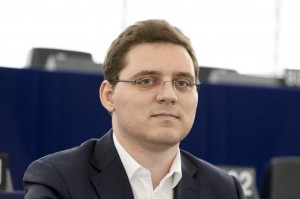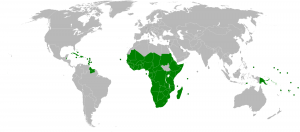Migration-related words seem to have become the buzzwords of 2015 lexicon: about 60 million refugees worldwide, millions of economic migrants, almost 100 million people dependent on everyday humanitarian aid to survive, large-scale displacements in Ukraine, millions at risk of famine in South Sudan, 5 years of conflict in Syria, 1 year of ISIS, plenty of minorities slipping into oblivion. The picture looks gloomy at the moment and the phenomenon of migration is both academically and professionally challenging.
*
Alexandra: We are interviewing Irina Mihalcuţ, a young professional in international development with a strong background in migration policies.
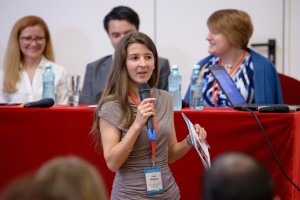
Irina, June 2014 ©StudioAlb
The concept of migration has a very special meaning for you. It can be translated through many stories and serendipitous moments that have marked your personal and professional path. With a Master Degree in Migration and European Affairs from Université Libre de Bruxelles (Belgium) and Babes-Bolyai University (Romania), your first professional experience with the phenomenon of migration was in Italy where you worked as a Cultural Mediator and Social and Legal counselor for a local immigration office. Before joining the team of UNCHR in Malta you have experienced the status of a foreign student in Belgium and the one of a migrant in Italy, Belgium and South Korea.
What first made you to choose migration as the core topic of your studies and then, of your profession?
Irina: Yes, as you have mentioned already, the concept of migration has played a very important role in my life. When I was about 13 years old, I heard from my family about an uncle of my father who ran away from Communist Romania and became a refugee in France. He was a Catholic priest in a small village in the region of Moldova and he tried to oppose the Regime through different actions in his community. Of course, he was living with the constant fear of being stopped by the authorities but despite that he continued his work, mainly in awakening the community through his preaching. One day, the Securitatea was informed and of course they took him for questioning. I do not know all the details related to what exactly happened to him after, but apparently one day he just disappeared and nobody from the family saw him again. Only after the fall of the Communism, they found out that he became a refugee in France. There, apparently, continued to work as a priest until his death. Some years ago I actually have managed, by chance, to find a book written by him during his stay in France. It is really incredible to have found a copy of that book with his signature on it. It was a very emotional moment!
This family story was the starting point for me in getting interested in the topic of asylum and migration. It would have been great if during High School we had had some classes about migration. Not necessary as a separate subject, but somehow integrated in the curricula of another subject, like History or Social Sciences. That would have helped me understand earlier so many issues related to this phenomenon, which is part of the human history since its beginnings. Migration affects almost everybody’s lives in our current society and it is important to make people think from an earlier age about the consequences of migration, the effects of conflicts and what it means to be a refugee. Only like that we can diminish and, hopefully, even eliminate rampant racism, discrimination and xenophobia which are so much prevant in our societies these days. Only like that we can prevent the manipulation of the masses by media and politicians.
The second main reason why I became so much interested in the migration phenomenon is also a personal one. My mother has become an economic migrant in the late ’90s. She was “forced” to leave Romania by the economic situation in our town and her desire to make sure that I have a better future. She had to leave me alone while I was still in High School and that had a tremendous impact on the way I have perceived and led my life afterwards. Through her experience as a migrant I have learned about the many difficulties a foreigner can encounter while working and living abroad, I learned about the emotional costs that a migrant has to pay but, I also learned about the wonderful gifts that the world can offer to these courageous people. Yes, all persons who decide to leave their country for any reason, are very courageous people. Some have it easier than others, but for all of them the hearts will always long for something left back home: their family, a friend, a special place, a dish, a landscape, a feeling, a particular time in their youth etc.
The abovementioned reasons made me become interested in the topic of migration and determined me to become a migrant myself. Since September 2004, this life style has become my “full-time job” when I started my Master Degree in Brussels and I think I will not stop being a nomad for quite some time from now on. You know what they say? Dust if you must, but the world’s out there/With the sun in your eyes, the wind in your hair,/A flutter of snow, a shower of rain,/This day will not come around again... as in Rose Millingan’s poem.
Alexandra: In Italy you used to work with refugees and economic migrants seeking for a better life in Western Europe. What have been the common misconceptions about migration that you encountered in your work at the immigration office in Italy?
Irina: Yes, I had the chance to work with refugees and economic migrants in Italy for some time in 2005 and in 2007. It was a very challenging experience for me, since I was still at the beginning of my professional career; nevertheless, during those times, I learned a lot about what I wanted to do in the future. And more than that, through interaction with colleagues from different teams I worked with I learnt how to balance emotions, reactions and actions, how to become a good professional in such a tough environment.
During those times, I understood that there are three types of professionals working in the migration and asylum environments: 1) the pastoral ones – these are the ones who give everything to the people they are working for; they do not separate their personal lives from the work life; they do not have the strength to say “no” when is needed; they are the ones who are ready to listen to the life story of a person for the tenth time at three o’clock in the morning; 2) the technical ones – these are the ones who do not shed a tear when they hear a horrific story form a war situation; they are the ones who will stop the interview with five minutes before the end of their working office hours and, even if that moment might be crucial for the status determination of that case, they do not care; 3) the techno-pastoral ones – these are the ones that can show compassion, but who can also say when needed now it’s enough! Take your life in your hands and start living again, do not expect the system to do it for you!; they are the ones who separate their personal lives from the work life but who can say Hi! How is your family? How were things for you lately? whenever they meet a migrant/refugee on the street.
In my opinion, the first two types are often met in the migrant/refugee contexts (including in the Italian Immigration Office where I worked) and are very dangerous. The professionals falling in the first category create most of the time an emotional dependency for their clients and the ones found in the second category provoke fear and inhibition in the hearts and minds of the migrants/refugees with whom they deal with. These two categories of professionals contribute a lot to the failure of the projects and programmes they try to implement and they fuel very much the misconceptions about what migration and asylum seeking means. On one side, the migrants/refugees either believe that their lives are in the “hands” of the system or they just avoid telling the truth because they fear the system (depending on what type of professionals they deal with). On the other side, these failed projects and programmes are used by media to create sensational news, by politicians to create “catchy” propaganda slogans and by hosting communities to blame foreigners for their socio-economic problems.
From my point of view, the third category of professionals – the techno-pastoral ones – are the best. They are the ones giving the emotional comfort needed so much by the migrants and refugees, laying the foundation for trust and truth and for successful personal stories, but in the same time they are the ones ready to tell at the right moment that is time for the migrants/refugees to take their lives in their hands and not to behave constantly as vulnerable and victims.
I have mentioned these categories of professionals working in migration and refugee contexts because I believe they are very often the main responsible for the existence of many misconceptions about migration and the way they act influences a lot how migration and asylum seeking are perceived by everybody.

Irina Mihalcut (in the middle) with her colleagues at UNCHR, World Refugee Day (2011)
Alexandra: Working with UNCHR in Malta (2009 – 2012) while the new office was opening in Valletta was definitely a great professional challenge. What were your main tasks and how did a day-to-day work look for you? What gave you most job satisfaction?
Irina: Yes, you are right. It was a very challenging professional experience working with UNHCR in Malta while the new national office was established. The Country Agreement between UNHCR and the Government of Malta was just signed when I arrived in the archipelago (the summer of 2009) and the initial steps for the set-up of the office had to be finalized by the end of the same year. I started my employment with UNHCR sometimes in November, mainly due to bureaucratic delays related to a slow national process for getting the work permit in Malta. Yes, I was again experiencing on my own skin what it meant to be a migrant.
I have been hired to assist the Country Representative in all aspects related to the set-up of the new office. My tasks were very technical at the beginning and mainly related to logistics, procurement, administration, human resources, IT and finance. I have received an empty building, that required a lot of repairs and improvements, and my task was to make that place a functional office. In the first months, a “normal” day at the office meant long hours of technical work and learning. I was new in Malta and in the same time it was my first experience in such a large organization built on a very complex system of rules and regulations and I had very little time to “get used to it”. I had to do it fast and I had to ensure that everything was done according to the UN requirements and in accordance with the local rules and regulations.
After the whole rush for the set-up of the office has ended, I also started getting involved directly in the other activities planned by the UNHCR office. Therefore I was also going with my colleagues from the Protection and Durable Solutions departments in the open and closed centers to do registration of persons of concern (PoC), to distribute non-food items to the newly arrived, to do counseling or simply to monitor what was going on in the different locations. In 2010, due to the large number of new arrivals coming from North-Africa (due to the Arab Spring revolutions), the UNHCR office has started also an intra-European Relocation Project, in which Romania took part as well. Since our office team was small and our projects were many, I helped my colleagues in identifying and counseling the PoC to be submitted for relocation to one of the ten EU states who offered to share the burden with Malta.
In 2011, apart of all the above mentioned activities, I was also involved in the preparation of a contingency plan for Malta in coordination with the other UN agencies present in the country and with the local authorities (especially with the Maltese Civil Protection). We needed to do that so that we could respond immediately to large influxes of asylum seekers coming in the archipelago. We set-up the first non-food items warehouse in Western Europe and that implied a lot of coordination with our offices from the region, from the HQ and from the Middle-East (where the items were shipped from), with shipping companies and of course with the local Maltese authorities.
During the three years I have spent with UNHCR Malta, I did a lot of interesting activities and my days of work were extremely diverse, because I was interested in learning a bit from all the departments. I was hired for a very technical post but I wanted to be also close to the PoC as much as possible. My joy and satisfaction during this professional experience came from seeing my team happy because they had a functional office and from the reactions of the different PoC that I have interacted with. For example, one day in 2011 I have received a phone call from one of the Ethiopian refugees that I worked with. He called me to tell that he was accepted to be relocated to Norway (where one of his brothers was living) and he wanted to thank me for the way I encouraged him one day while I did a visit in the center where him and his family were hosted. He said that my kind words and the way I behaved gave him courage and hope, and that was a turning point in his life which marked the beginning of a new personal chapter. That was an emotional moment for me and I was given an insight into what an important role me and my colleagues had in the life of those people. I still keep in touch with him and I am so happy to hear that him and his family are achieving so much in their new home country.
From this professional experience I learned that no matter what you do, if you do it with enthusiasm, if the things you accomplish are done with love and a sense of purpose, then you can change lives.
Alexandra: In Romania, you were the National Focal Point for Romania for the European Resettlement Network (2013-2014). During that period, 40 selected Iraqi refugees have been resettled from their camp in Turkey to Romania. These days there is a huge debate about hosting a certain quota of refugees from Syria in Romania. From your experience gathered during the abovementioned experience, how would you assess the main challenges encountered by the responsible authorities and the Romanian civil society during the current debate about welcoming and integrating refugees?
Irina: Indeed, in my role as ERN NFP for Romania, I had the chance to get involved also in the different discussions held at the national level, about the resettlement of 40 Iraqi refugees to Romania. During those discussions it became very clear that Romania had still a lot of difficulties in welcoming and facilitating the integration of persons in need of protection. There were several factors that contributed and still contribute to this situation: 1) the Romanian asylum system is still quite young, 2) the lack of real coordination between the different non-governmental organization in the country is still present, 3) the economic problems and the lack of jobs at the national level are current topics, 4) the small immigrant communities present in the country, 5) the low involvement of the administrative authorities from the local levels and of course 6) the desire of the refugees to have a better new start in life which would be assured by a more developed country in the Western of Europe.
When we think about welcoming asylum seekers and persons with a form of protection, both in Romania and in Europe in general, we have to remember that we are talking about saving lives first of all and, in my opinion, this element is often placed on a secondary place by the different actors involved in the discussions. Recently the President, Mr. Iohannis said that Romania is ready to welcome 1785 in need of protection while the EU said that Romania should take 6351. When I hear these discussions I feel like we are at a market where things can be negotiated. No, lives cannot be negotiated!
I understand the different issues connected to receiving new asylum seekers, especially when they come from a very different social and religious context, but we do have to open our country and our continent to saving as many people as possible no matter where are they coming from, no matter how educated they are and no matter how strong they are. I still remember the ridiculous criteria used by some countries in receiving refugees for relocation from Malta. They had to be Christians, educated, to speak one foreign language, to not need special medical care and/ or to not want family reunification.
Did Romanians forget that we were “exporting” refugees during Communism? Did Europeans forget that a total of about 60 million Europeans became refugees during the entire World War II period and that (according to the UN) a million people had yet to find a place to settle down by 1951, more than five years after the fighting stopped? What would have happened to those Europeans if the borders would have been closed for them when trying to escape war and famine?
Of course, there are some countries better ecquiped than others that can accept persons în need of protection, but this is a very cheap excuse from some European governments (especially în the Eastern Europe) and it is time to look at values that are beyond economical and financial matters: like hospitality and humanity.
At the same time, it is the moment for the finalization of a common European Asylum system and for a bigger freedom of movement within the EU borders for all persons with a form of protection. If it will be put in place an easyer way for these persons to move and to compete for the labour market around the EU member states, then there will be less trafficking and less irregular work. There will be less traumatized people, less „asylum shopping” and more competition on the labour market which, on a longer term, will inevitably motivate both the European citiziens and the persons with a form of protection to learn new skills and develop personally and professionaly.
Imagine if all asylum seekers would be allowed to work and study immediately after their registration with the local authorities, then there will be a smaller need for financial support from the local entities and those persons would learn immediately more about the hosting society, they would be able to make friends from amongst the locals, they would learn the local language faster and they would keep themselves busy while waiting for the result of their status determination. Briefly, the process of integration would be much faster and more successful! In my opinion, if governments around Europe would focus more on supporting and welcoming than on prohibiting and limiting, the current situation would not be defined as a “refugee crisis” but rather a “new page in the European humanitarian intervention”.
 Alexandra: Less than one month ago, the new Sustainable Development Goals have been adopted by the world leaders gathered at the UN Summit in New York. The goal no. 10 and more specifically the target 10.7 include specific references related to migrants and the migration phenomenon. How would you comment the importance given to migration in the current Post-2015 Agenda?
Alexandra: Less than one month ago, the new Sustainable Development Goals have been adopted by the world leaders gathered at the UN Summit in New York. The goal no. 10 and more specifically the target 10.7 include specific references related to migrants and the migration phenomenon. How would you comment the importance given to migration in the current Post-2015 Agenda?
Irina: While I was working as NFP for ERN in Romania, I had the opportunity to participate in July 2014 to the Development Camp organized by FOND Romania. That edition was dedicated to the discussions related to the international agenda post 2015 and it was part of the “global conversations” meant to identify the priority areas to be addressed in the SDG goals. During the discussions held there it became clear that migration had to be included in the list of specific targets for the new development goals because this phenomenon is an integral part of the international development. Foreigners can contribute very much to the diversification of local economies and can refresh the local societies. Because of their presence the locals will find a stronger motivation to learn new skills and find new opportunities. In most of the cases, every migrant contributes to the global fight for reducing the social and economical inequalities. If all people can assert their interests without the fear of becoming “illegals or irregulars” the process of reducing poverty around the world will go much faster.I am very glad to see that migration was included in the list of targets for the new development goals. The now expired MDGs did not mention anything specific about migrants or persons in need of international protection and it was about time to include this topic in the global agenda.
“Regular and responsible migration and mobility of people”, “implementation of planned and well-managed migration policies” are notions much needed in the new global agenda. The MDGs were meant to be applied to all the countries in the world but in fact they became targets for poor countries to achieve with financial support from the wealthy states and, the inclusion of a topic like “migration” shifts the pressure on all the countries (including the wealthy ones) to contribute to the achievement of the new goals.
Alexandra: The daily path never ends says an African/ Masai proverb. A couple of months ago, you moved to Tanzania where you work with a local NGO. Could you tell us more about your projects over there? How does this experience match with your migration-related professional background?
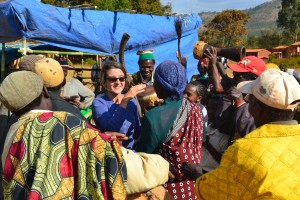
Lugarawa, Tanzania (2015)
Irina: I arrived in Tanzania at the end of February 2015 and immediately after I have started my collaboration with a local foundation. I live in a small village (of about 2000 people) in the Southern-Highlands of Tanzania, not far from the border with Malawi, in a very fertile and picturesque area, but where the majority of people live beneath the poverty line and the population is heavily dependent on subsistence farming and various forms of aid. It is my first time in Africa and I am so lucky to live this experience in this village. I have decided to work with the foundation because I understood from my first meeting with the team that they are different. The motivation for doing something for their community and for contributing to the development of their region, was originating from their hearts and not from a foreign impulse or from a personal financial desire.
They are all volunteers and they did all their projects with very little financial support. The team is made mainly of doctors, teachers and business owners. It is a small team but, due to their energy and dedication, together we managed to achieve a lot in a very short time.
As Program Officer, I take care (among other things) of launching and coordinating new projects, of managing fund-raising actions, of planning new strategies and of changing the image of the foundation. Some of the projects we did in the past months included activities related to: 1) childrens rights; 2) respecting and protecting the environement; 3) prevention of conflicts; 4) identification of young leaders in the community; 5) supporting small business ideas; 6) identification of causes for poor performance in schools.
We did also a lot of meetings with local villagers, with students and local leaders during which we discussed also about asylum and refugees. We did this mainly because of two reasons: 1) Tanzania started receiving new asylum seekers coming from Burundi, due to the civil unrest related to the latest Burundian Presidential elections and 2) Tanzania has been preparing for national elections which will take place towards the end of October 2015. During our discussions we emphasised the fact that Tanzania is the most peaceful country in the region (and has been like this since its independence in the ’60s) and the only way for this country to remain like this is for its inhabitants to continue living peacefully in diversity and to contiue working assidously on preventing conflicts.
Apart of the above mentioned activities, we have recently organized a festival, which involved the communities from three villages. The festival had several components, including: 1) awareness about protecting the environment (in special the de-forestation of the mountains and the impact on the water sources in the area); 2) to re-connect those born in the area and who migrated to other destinations with their home communities; 3) the development of a ethno-historical research about the region; and 4) “planting the seeds” for the construction of a community center (where locals could have a library, could take various courses, could make cultural meetings).
The work that I currently do is not related to managing migration, however, it has provided me with an insight into the importance of migration at a micro level. For example, I understand better now the necessity of migration for personal socio-economic development (mainly related to access to education and labor market mobility) and the restrictions that potential migrants meet due to limited resources, high costs and lack of a network for information and experience exchange. And, yet another time, I am experiencing the life of a migrant. I am learning a new language, I am discovering a new culture and the most important, I understand much better what are the best ways of working efficiently in international development projects.



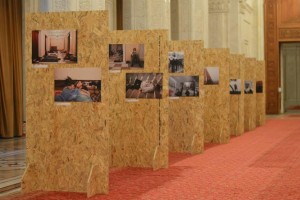
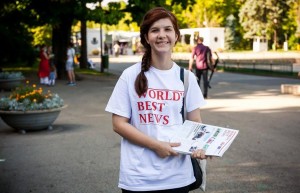



 Amnesty International Bucharest Group, the first and only local group of Amnesty International in Romania, was founded in August 2014 gathering at the very beginning 10 members only.Since then, the group developed and it consists now of 30 members who undertook four campaigns in order to raise awareness about refugee and asylum-seekers’ rights, sexual and reproductive rights, women’s rights, freedom of expression, political and civic rights and the ban of torture practices.
Amnesty International Bucharest Group, the first and only local group of Amnesty International in Romania, was founded in August 2014 gathering at the very beginning 10 members only.Since then, the group developed and it consists now of 30 members who undertook four campaigns in order to raise awareness about refugee and asylum-seekers’ rights, sexual and reproductive rights, women’s rights, freedom of expression, political and civic rights and the ban of torture practices. 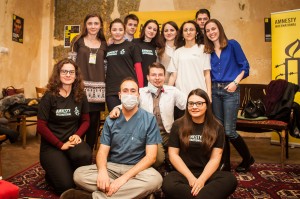 mpaigns with Amnesty as a Volunteer Facilitator, I have decided that I got enough experience and understanding of the way the organization works in order to move to the next level. Founding this group came from my desire to promote AI and its values in my country. I wish I couldbring my contribution towards changing the Romanian mentality concerning Human Rights, namely making ordinary citizens more tolerant and open to embrace diversity. A large number of them do not know what Human Rights are and have never had any Human Rights education in school or throughout their life. Thus, the degree of intolerance and discrimination in Romania is, at some extent, worrisome.
mpaigns with Amnesty as a Volunteer Facilitator, I have decided that I got enough experience and understanding of the way the organization works in order to move to the next level. Founding this group came from my desire to promote AI and its values in my country. I wish I couldbring my contribution towards changing the Romanian mentality concerning Human Rights, namely making ordinary citizens more tolerant and open to embrace diversity. A large number of them do not know what Human Rights are and have never had any Human Rights education in school or throughout their life. Thus, the degree of intolerance and discrimination in Romania is, at some extent, worrisome.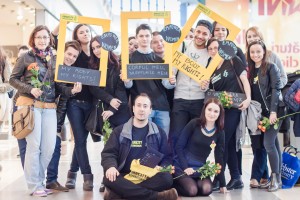 Ionela: If we are looking at all the 17 SDGs is hard to select the areas where we have to be more engaged. However, keeping in mind the real concerns of Romanians, I believe that ending poverty (or at least, diminishing it), increasing health care, investing in quality education and promoting sustainable, inclusive economic growth are the areas were we should invest more. Let me also add that achieving greater equality and empower women and girls should be one of our priorities and we need to keep on fighting the battle in order to reduce domestic violence, end human trafficking (affecting young girls and women in general), and ensure access to sexual and reproductive health and reproductive rights. In this direction, I totally support the idea of having sexual and reproductive education programs in schools. At the moment, the rates of teen birth and abortion (under 19- year old girls) in Romania are one of the highest in Europe; moreover, 60% of sexual active teenagers (teenagers between 15-19- year old) have never used contraception. This can be a real problem not only in terms of birth or abortion numbers, but also concerning the spread of STDs. Needless to add, the economic impact on the state.
Ionela: If we are looking at all the 17 SDGs is hard to select the areas where we have to be more engaged. However, keeping in mind the real concerns of Romanians, I believe that ending poverty (or at least, diminishing it), increasing health care, investing in quality education and promoting sustainable, inclusive economic growth are the areas were we should invest more. Let me also add that achieving greater equality and empower women and girls should be one of our priorities and we need to keep on fighting the battle in order to reduce domestic violence, end human trafficking (affecting young girls and women in general), and ensure access to sexual and reproductive health and reproductive rights. In this direction, I totally support the idea of having sexual and reproductive education programs in schools. At the moment, the rates of teen birth and abortion (under 19- year old girls) in Romania are one of the highest in Europe; moreover, 60% of sexual active teenagers (teenagers between 15-19- year old) have never used contraception. This can be a real problem not only in terms of birth or abortion numbers, but also concerning the spread of STDs. Needless to add, the economic impact on the state.
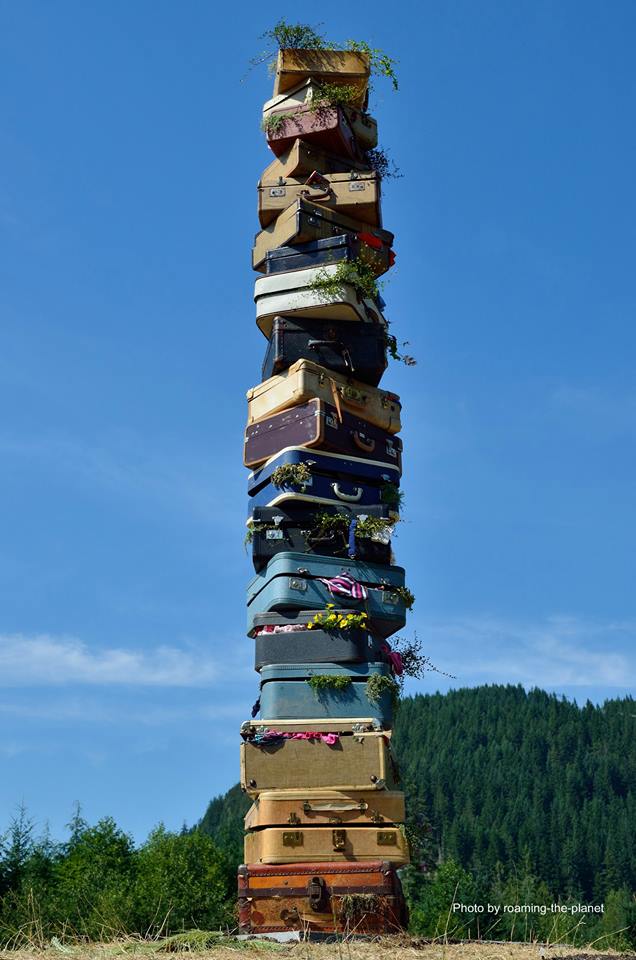

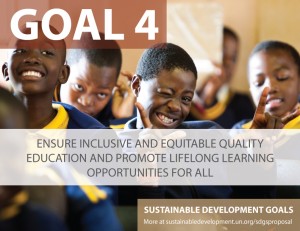
 e seek to inform the local public on the global priorities set through the new global agenda (for example see our
e seek to inform the local public on the global priorities set through the new global agenda (for example see our 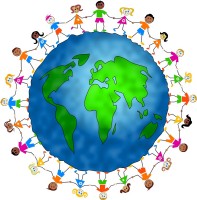
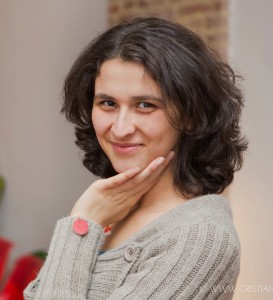






 cs of ARCADIA?
cs of ARCADIA?
